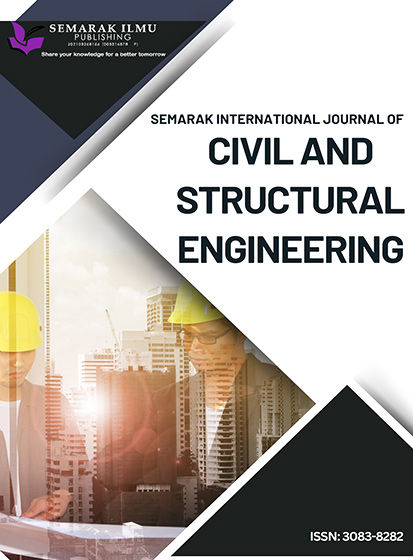Sustainable Use of Spent Bleaching Earth as Partial Cement Substitute in Cement Sand Brick
DOI:
https://doi.org/10.37934/sijcse.4.1.2230Keywords:
Spent Bleaching Earth Pozzolanic, Portland Limestone Cement, River Sand, Sieve, Water Absorption, StrengthAbstract
This study investigates a use of spent bleaching earth pozzolanic, byproduct of biodiesel production, as sustainable substitute in the cement mortar. As a waste material, spent bleaching earth pozzolanic present viable solution for enhances construction materials while reducing environmental impact. The study aims to assess spent bleaching earth pozzolanic effectiveness as a partial cement replacement in a cement mortar, focusing on its effect on material properties and structural performance at varying replacement levels of 10%, 20%, 30%, 40%, and 50%. Tests conducted include the sieving analysis, water absorption, and compressive strength. The results indicate Portland limestone cement in 75 µm pan sieve weighed for 69 g, and a spent bleaching earth pozzolanic weighed for 77 g, with respective indicating a potential for improved particle packing. By increasing the spent bleaching earth pozzolanic in Portland limestone cement with river sand for cement sand brick, reduce the water absorption values of 0%, 10%, 20%, 30%, 40%, and 50% spent bleaching earth pozzolanic for 9.8%, 9.6%, 9.4%, 9.2%, 9.1%, and 9% at 28 days. The packing packed of Portland limestone cement, spent bleaching earth pozzolanic, and river sand showed as spent bleaching earth pozzolanic increased, the water demand slightly decreased, resulting in compressive strength values suitable for load-bearing application. Finding suggest spent bleaching earth pozzolanic effective as binder at 20% replacement, providing enhance performance without compromising cement sand brick strength, thus supporting the material’s potential in the eco-friendly construction. This research contributes to the sustainable utilization of the industrial byproducts, proposing spent bleaching earth pozzolanic as viable ingredient in building materials that balances mechanical properties with environmental benefits.













